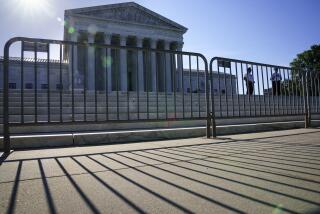Supreme Court should lift its blackout
- Share via
Why theU.S. Supreme Courtcontinues to hold its oral arguments away from television cameras remains a mystery and a national shame. On Monday, the court will begin hearing six hours of arguments over three days in a lawsuit brought by more than half of the states in the nation to challenge the constitutionality of the Patient Protection and Affordable Care Act, one of the most important pieces of economic legislation passed by Congress since the New Deal. The stakes of the litigation could not be higher. How the court rules is likely to affect healthcare in this country for generations and could even affect the outcome of the presidential election.
Who will get to witness this historical event? Only the justices, the lawyers, a few reporters and 250 lucky individuals whose tenacity and financial ability will allow them to camp out in front of the court — perhaps for days — before the hearing begins. The court has said it will provide same-day (not live) audio coverage of the oral arguments. There will be no television at all, not even on tape.
We should be outraged by this decision. Supreme Court proceedings are not simply government events; they are important historic moments and are of major educational, civic and national interest. There is a strong presumption that people should be able to watch government proceedings, and in ones as vitally important as this, the public has an especially great interest in transparency.
Those very few academics and politicians who argue against live television in the court usually raise several arguments, none of them convincing.
First, they suggest that televising the arguments will lead to showboating by lawyers or judges for the cameras. Many state courts, however, at all levels allow televised proceedings, and there have been no problems with improper attorney or judicial behavior.
Second, some have argued that if television cameras were allowed, the media might broadcast excerpts that offer a misleading impression of the arguments or show the proceedings and the participants out of context. But that could just as easily happen with the audio released at the end of the day, or even when journalists report on what they heard in court. A newspaper or television reporter could quote a justice’s question or a lawyer’s answer out of context under the current blackout rule. The Supreme Court should not be able to protect itself from misreporting any more than any other government institution holding a public hearing.
Perhaps the justices are afraid that an excerpt of oral arguments might appear on Jon Stewart’s “The Daily Show” or Jay Leno’s”The Tonight Show” and be used for entertainment or comedic purposes. That certainly could happen. But in a democracy, even those in prominent positions are fair game for satire. In no other context would Supreme Court justices say that government officials should be allowed to protect themselves from possible criticism by cutting off public access to public proceedings.
The Senate Judiciary Committee has debated bills requiring the Supreme Court to allow cameras. The full Congress should act on these proposed laws as soon as possible.
The United States is the only country in which Supreme Court justices have lifetime appointments. That is all the more reason that their actions should be transparent and that they should not be allowed to shelter themselves from public scrutiny. Watching Justice Antonin Scalia ask a biting, sarcastic question, or Justice Anthony M. Kennedy play law professor with a brilliant adversary, or Justice Elena Kagan stare down an attorney who evades a difficult question would give the American people just a little more insight into some of their most important leaders, and into how a critically important branch of government works. We have a right to be included — especially when the court is hearing a case concerning the constitutionality of the Affordable Care Act, which might dramatically alter American life for decades.
The Supreme Court announced Friday that it will allow the broadcasting of the audiotapes of oral arguments immediately after they conclude.
C-SPANsaid that it will do this. But if people can hear audiotapes just minutes after the arguments are finished, it is impossible to see the harm in allowing them to see the proceedings live just an hour earlier.
Obviously, there should be television cameras in the Supreme Court, and it should happen by Monday. It is time for the Supreme Court to enter the 21st (or at least the 20th) century.
Erwin Chemerinsky is dean and professor of law at the UC Irvine School of Law. Eric J. Segall is a professor of law at the Georgia State University School of Law
More to Read
A cure for the common opinion
Get thought-provoking perspectives with our weekly newsletter.
You may occasionally receive promotional content from the Los Angeles Times.






